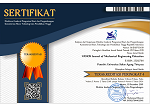EVALUATION OF ELECTRIC AND ELECTRONIC HANDOUT IN AUTOMOTIVE NGEINEERING BY USING FORMATIVE EVALUATION PROCESS
Abstract
Keywords
Full Text:
PDFReferences
Antoni B., & Lucrecia C C. (2018). Teachers learn about student learning assessment through a teacher education process. Studies in Educational Evaluation, 58(2), 1-7.
Bloom, B. S. (1956). Taxonomy of educational objectives: handbook 1, cognitive domain. New York: David McKay.
Borg, W.R. & Gall, M.D. (1983). Educational research an introduction. Fourth Edition. New York: Longman.
Carolien A.N. Knoop V C, Eliane S, & Ludo V. (2020). Effects of audio support on multimedia learning processes and outcomes in students with dyslexia. Computers & Education. 150(2), 103858
Chiung E H (2020). Discovering the creative processes of students: Multi-way interactions among knowledge acquisition, sharing and learning environment. Journal of Hospitality, Leisure, Sport & Tourism Education. 26(3), 100237
Dick, W., Carey, L., & Carey, J.O. (2009). The systematic design of instructional. London: Pearson Education Ltd.
Gall, M.D., Gall, J.P., & Borg, W.R. (2007). Educational research an introduction. Eighth Edition. London: Pearson Education Ltd.
Higinio M., María T S P, Andrés F G, María L. & Pertegal F. (2020). A collaborative working model for enhancing the learning process of science & engineering students. Computers in Human Behavior. 103(1), 140–150
Katerina S. (2018). From structure to process: Do students' own construction of their classroom drive their learning?. Learning and Individual Differences. 62(4), 36–48
Moleong L J. (2005). Metodologi Penelitian Kualitatif, Bandung: Remaja. Rosdakarya. T.Hani.
Muslim, Martias, & M. Nasir. (2019). Correlation of activities learning with learning outcomes student in vocational high school, Journal of mechanical engineering education. 4(2), 137-148
Muhammad K. (2019). Assessment of teaching material in mechanical engineering drawings Journal of mechanical engineering education. 4(2), 115-124
Sugiyono. (2005). Memahami Penelitian Kualitatif. Bandung: CV. Alfabeta.
Toto S, Dwi S P, & Wawan P. (2017). Analysis on the role of engine coolant temperature sensor in gasoline engine. Journal of mechanical engineering education. 2(2), 145-152
DOI: http://dx.doi.org/10.30870/vanos.v5i1.8211
Refbacks
- There are currently no refbacks.

This work is licensed under a Creative Commons Attribution 4.0 International License.


.png)
.png)
